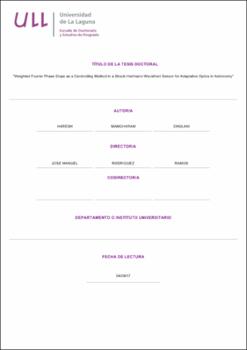"Weighted Fourier Phase Slope as a Centroiding Method in a Shack-Hartmann Wavefront Sensor for Adaptative Optics in Astronomy"
Author
Mangharam Chulani, HareshDate
2017Abstract
Se presenta el método de cálculo de centro "Weighted Fourier Phase Slope" para la imagen de subpupila de un sensor de frente de onda tipo Shack- Hartmann, y se explora su comportamiento para estrellas guía puntuales. Este algoritmo estima el desplazamiento de la imagen en el dominio de Fourier, calculando directamente la pendiente de la fase en varias frecuencias espaciales, sin el paso intermedio de calcular la fase; entonces aplica pesos óptimos a dichas pendientes obtenidos por medio de una estimación Bayesiana. La idea está inspirada en técnicas de deconvolución cepstrum, y se ilustra esta relación. Se caracteriza el comportamiento del algoritmo para estimar el tilt, y se contrasta con otros métodos conocidos, como el centro de gravedad umbralizado (TCoG) y la correlación cruzada (CC), primero por medio de simulaciones numéricas a nivel de subpupila, luego a nivel de pupila entera, y finalmente en un banco de pruebas en laboratorio. Los resultados muestran una sensibilidad similar a la de la CC, que es superior a la del TCoG cuando se necesitan campos de visión extensos, como por ejemplo en un sistema de óptica adaptativa configurado para corrección en lazo abierto; de esta manera, se aumenta la magnitud límite de la estrella guía en 0.6 - 0.7. Por otro lado, su ventaja con respecto al algoritmo de CC es un orden de magnitud menos, aproximadamente, de coste computacional. The Weighted Fourier Phase Slope centroiding algorithm at the subpupil image of a Shack-Hartmann Wavefront Sensor is presented, and its performance for point-like guiding sources is explored. This algorithm estimates the image's displacement in the Fourier domain by directly computing the phase slope at several spatial frequencies, without the intermediate step of computing the phase; it then applies optimized weights to the phase slopes at each spatial frequency obtained by a Bayesian estimation method. The idea has been inspired by cepstrum deconvolution techniques, and this relationship is illustrated. The algorithm's tilt estimation performance is characterized and contrasted with other known centroiding algorithms, such as Thresholded Centre of Gravity (TCoG) and Cross Correlation (CC), first through numerical simulations at a subpupil level, then at a pupil level, and finally at a laboratory test bench. Results show a similar sensitivity to that of the CC algorithm, which is superior to the one of the TCoG algorithm when big fields of view are necessary, i.e., in an open loop configured adaptive optics system, thereby increasing the guide star limiting magnitude by 0.6 - 0.7. On the other side, its advantage over the CC algorithm is an approximately one order of magnitude lower computational cost.





